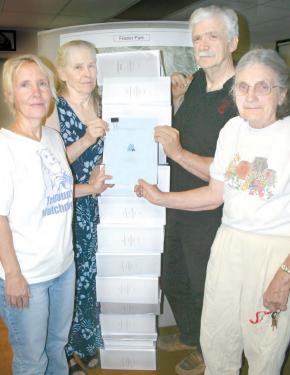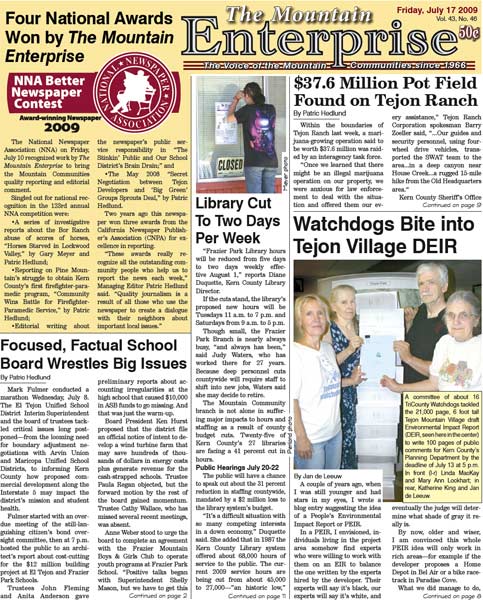
A committee of about 16 TriCounty Watchdogs tackled the 21,000 page, 6 foot tall Tejon Mountain Village draft Environmental Impact Report (DEIR, seen here in the center) to write 100 pages of public comments for Kern County?s Planning Department by the deadline of July 13 at 5 p.m. In front (l-r) Linda MacKay and Mary Ann Lockhart; in rear, Katherine King and Jan de Leeuw.
By Jan de Leeuw
A couple of years ago, when I was still younger and had stars in my eyes, I wrote a blog entry suggesting the idea of a People’s Environmental Impact Report or PEIR.
In a PEIR, I envisioned, individuals living in the project area somehow find experts who were willing to work with them on an EIR to balance the one written by the experts hired by the developer. Their experts will say it’s black, our experts will say it’s white, and eventually the judge will determine what shade of gray it really is.
By now, older and wiser, I am convinced this whole PEIR idea will only work in rich areas—for example if the developer proposes a Home Depot in Bel Air or a bike racetrack in Paradise Cove.
What we did manage to do, through TriCounty Watchdogs is to edit and coordinate the local comments on the DEIR for Tejon Mountain Village. This produced a 100-page booklet with 12 comment letters on the chapters of the DEIR. With no money and with the impossible CEQA deadlines enforced by the Kern County Planning Department (the lead agency) I am not sure we can do much better. Here is a summary of the contents:
Lynn Stafford wrote an executive summary, with comments on the flawed input procedure, the omission of Castac Lake from the DEIR, the urban sprawl introduced by the project and the negative consequences for taxpayers and local business owners, the impacts on the Condor Recovery Program and the cumulative impact of the Tejon projects on Interstate-5.
Eric Anderson discusses impacts on the principles of the International Dark Sky Association and the negative effect on eco-tourism plans for this region. He also mentioned the viewshed from I-5, and the unshielded floodlights at Tejon Ranch corporate headquarters.
Linda MacKay argues that the DEIR does not correctly present the current ozone and particulate matter levels in the Tejon Pass near the middle school. She criticizes the Voluntary Emissions Reduction Agreement between Tejon and the air board, setting a mitigation amount [a $10 million payment to the air board] before the project’s scope was fully known or analyzed.
In a joint letter the TCW board criticizes the DEIR (and the DEIS for the Habitat Conservation Plan) for not adequately analyzing and mitigating black carbon and greenhouse gas emissions generated by the project.
Lynn Stafford writes on impacts on biological resources. He points out the lack of (community) oversight, lack of specificity in location of the homes and said that the environmental impacts of the golf courses and lake management are not correctly considered.
Katherine King comments on the Tejon Ranch Conservation and Land Use Agreement [which created the Tejon Ranch Conservancy], its costs to the taxpayer and why it is inappropriate and inadequate as mitigation for the project. [For instance, if a 2011 deadline for acquiring conservation easements ‘at market value’ during this economic downturn is not met, financial support for the Conservancy is curtailed. Additionally, of the county grants entitlements before an appraisal is made, the cost to the public is likely to increase dramatically].
Jan de Leeuw points out inaccuracies and biases in the local history presentation in the cultural section of the DEIR.
Mary Ann Lockhart discusses dangers from earthquakes generated by the Garlock and San Andreas faults, which have a roughly 50 percent probability of rupturing in the next 30 years, with the possibility of a 10-30 feet surface displacement.
Doug Peters criticizes removing Castac/Tejon Lake from the project. In previous presentations it was always part of the project, and in fact it still is TMV’s centerpiece. He discusses water quality, groundwater supply and flooding issues connected with the lake that are impacted by the project.
Mar Preston goes over impacts on local jobs and tax payers, and on the lack of long-term benefits for the community. She uses the economics of Pine Mountain Club as a model for the evolution of Tejon Mountain Village.
The TCW board then analyzes surface water supply issues, in the light of ever-decreasing allocations from the State Water Project.
The supply amounts available to the project are overstated, do not adequately take climate change and Bay Delta developments into account, and fail to address the cumulative impact of other local developments.
Jan de Leeuw comments on the impact of cumulative Tejon developments on I-5 traffic. He argues the projects will triple the amount of car traffic and quadruple the amount of truck traffic over a 30-year interval, with very serious consequences for traffic flow, pollution of the pass, greenhouse gas emissions and commuter well-being.
You can see their work online at www.cuddyvalley.org/projects/tmv/tmv_deir.pdf.
A URL for the developers’ DEIR is www.cuddyvalley.org/tcwdogs/?q=node/33.
This is part of the July 17, 2009 online edition of The Mountain Enterprise.
Have an opinion on this matter? We'd like to hear from you.


